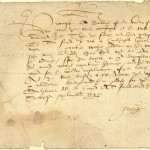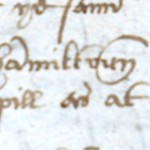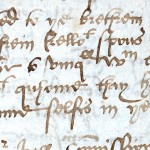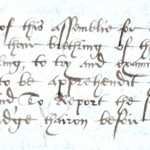By 1597, King James VI of Scotland was something of an expert on witches and the occult. Since 1590, James had lived in fear of murderous attacks from those using unearthly powers to commit treason against him. In that year, around 100 people in the small town of North Berwick had been tried for witchcraft. It began with the confession of one Gillis Duncan, a maid in the town who then went on to implicate a number of other people. They severally confessed to meeting in the local church at night to do all kinds of evil, including attempting to wreck the King’s ship on his return from Denmark with his new Danish wife, Anne. After this incident, James took it upon himself to study what he referred to as ‘Daemonologie’ and showed great concern that covens of witches be hunted down and destroyed. He published a lengthy book on the subject with just that title in the same year that this letter dates from.
The study of witches at this time was regarded as a theological discipline. It was widely believed that all witches had made a pact with the Devil and gathered in groups to work their evil. As a consequence of this belief, in cases where one woman was accused and confessed to being a witch (usually under torture), there would be efforts made to locate the others in her group and associates would be sought out and tortured in their turn until all the relevant names had been identified. The term ‘prickat wiche’ used in this letter refers to the belief that immunity to pain in certain parts of the body was a sign of a witch and therefore tests were devised for this involving long needles. The “witch” of the letter is known to have passed, or perhaps it should be failed, this test.
The witch referred to in the King’s letter is likely to have been either Elizabeth Hamiltoun, Catherine Kellot or Jonet Crawfurd. All are recorded in the Stirling Presbytery minutes for September and October 1597 as having been accused of witchcraft: –
On the 14th September 1597 the minute states ‘the quhilk day Rob[er]t Hamiltoun Sewster is accusit of Wichcraft and abusing of the pepill…’ His wife was also included in the accusation.
On the 5th October 1597 ‘it is reported to the brethren by their Co[m]missionaris appointed to try Witches that Catherin Kellot…in dollar and Jonet Crawfurd doghtir to umq[uhil]le W[ilia]m Crawfurd in Ed[inbu]r ar apprehendit for Witchcraft’.
The Commissioners referred to in the last entry are referred to in a minute of the Presbytery of 7th September 1597 where it is recorded that ‘The brethring of this assemblie for divers gude considera[ti]onis gevis Co[m]missione to their brethring of the Ministrie, qwha hes their residence in Stirling, to try and examin thais wome[n] alreddie apprehendit and to be apprehendit heiraftir for Wichcraft’.
There are no records held at the Council Archives to tell us what the outcome of these accusations was; some people were convicted at this time and some acquitted. Such accusations were a very serious matter as the punishment for witchcraft at this time was strangulation and then burning, a horrible fate.



